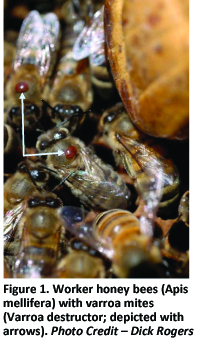Guide Equips Beekeepers of All Types with Tools to Tackle Parasite, Strengthen Hive Health

The Honey Bee Health Coalition, a diverse coalition dedicated to improving the health of honey bees and other pollinators, released a guide today aimed at helping beekeepers strengthen hive health by controlling the Varroa mite (Varroa destructor). This parasitic mite undermines honey bee health by literally draining the life from honey bees, spreading viral diseases, and wiping out vast numbers of hives along with the pollination services these bees provide. As a result, these tiny mites are one of the biggest threats to honey bees and global food production.
“Varroa mites are one of the most serious threats to honey bee health and hives across North America,” said Bob Sears, president of the Eastern Missouri Beekeepers Association. “This straightforward guide, compiled using the best available scientific and commercial information, will equip beekeepers — from hobbyists to commercial — with effective and environmentally sensitive approaches to monitoring as well as control techniques to ensure their colonies can endure.”
“These problematic parasites have demonstrated a startling resiliency and ability to spread to other honey bee colonies,” said Christi Heintz, executive director of Project Apis m. “This guide, developed by leading honey bee health experts, will ensure beekeepers can more easily confront the problem of Varroa mite infestations, better protect their own bees, and mitigate the parasites’ abilities to move into other nearby apiaries.”
The Honey Bee Health Coalition worked with Dr. Dewey Caron, emeritus professor of Entomology and Wildlife Ecology at the University of Delaware and affiliate professor at Oregon State University’s Department of Horticulture, to gather input from leading experts on Varroa mite control. The resulting guide identifies straightforward, proactive, and flexible monitoring methods and guidelines to help beekeepers detect and control Varroa mites.
The guide, which can be found at http://honeybeehealthcoalition.org/Varroa, lays out an Integrated Pest Management (IPM) strategy for managing Varroa mite infestations; including how to monitor mite levels, chemical and non-chemical methods to control the mites, and methods to determine which treatment is appropriate for a beekeeper to use at different phases in a colony’s life cycle.

The Honey Bee Health Coalition brings together beekeepers, growers, researchers, government agencies, agribusinesses, conservation groups, manufacturers and brands, and other key partners to improve the health of honey bees and other pollinators. Its mission is to collaboratively implement solutions that will help to achieve a healthy population of honey bees while also supporting healthy populations of native and managed pollinators in the context of productive agricultural systems and thriving ecosystems. The Coalition is focusing on accelerating collective impact to improve honey bee health in four key areas: forage and nutrition, hive management, crop pest management, and communications, outreach and education.
Through its unique network of private and public sector members, the Coalition fosters new partnerships, leverages existing efforts and expertise, and incubates and implements new solutions. The Coalition brings together diverse resources to promote communication, coordination, collaboration, and investment to strategically and substantively improve honey bee health in North America.
More information, including a list of Honey Bee Health Coalition members, can be found at: http://honeybeehealthcoalition.org.